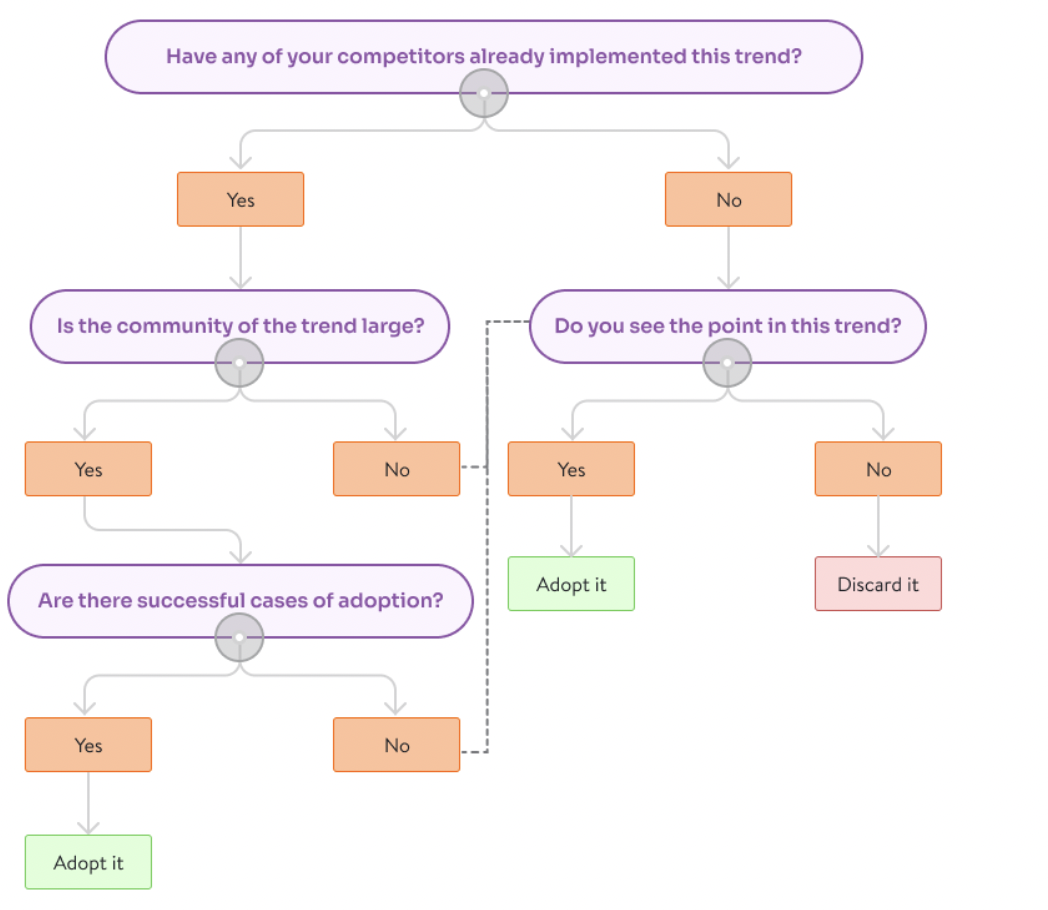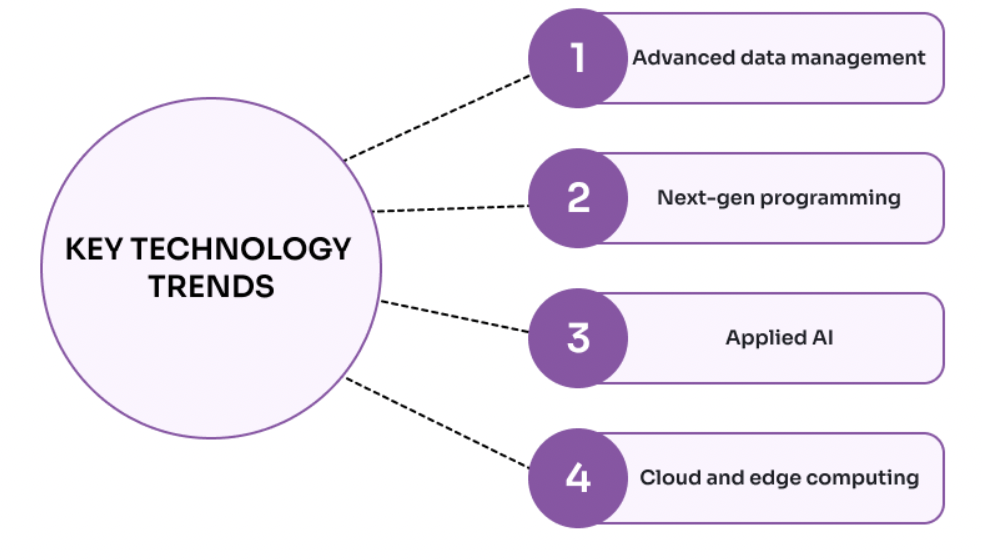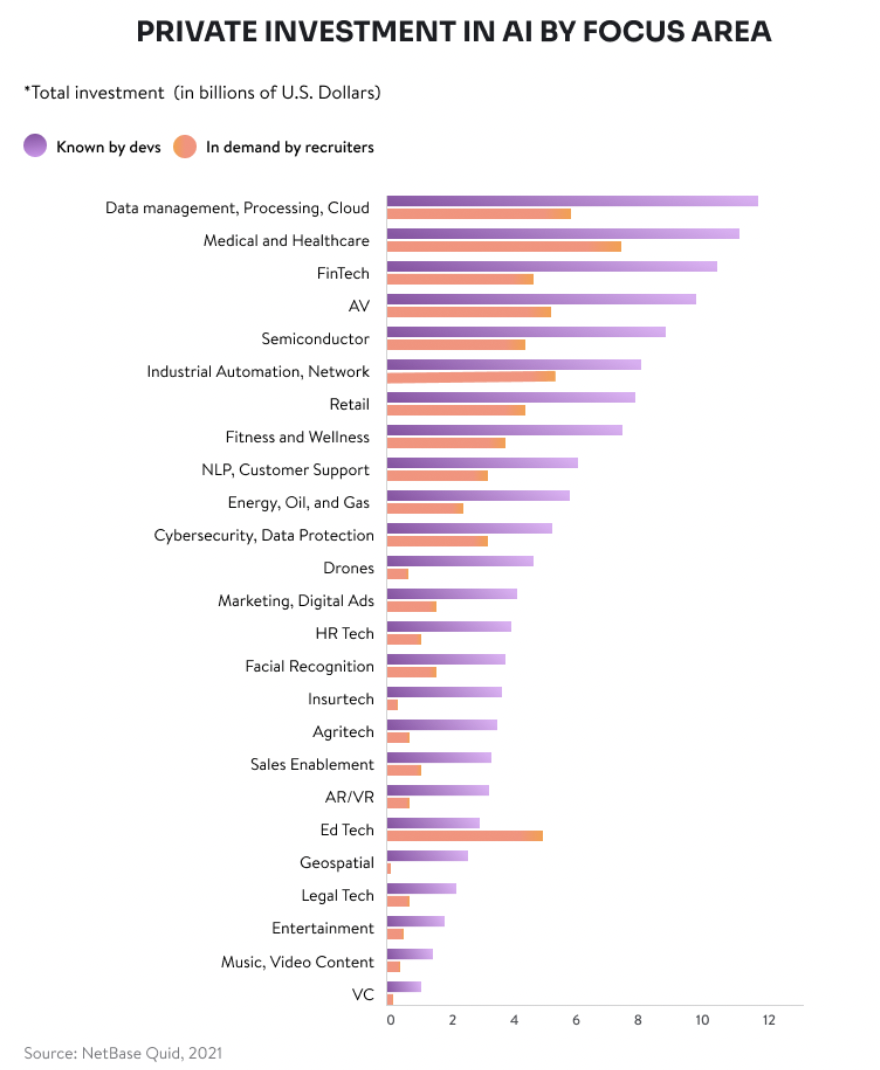7 Disruptive Technology Trends Dominating in 2023

7 Disruptive Technology Trends Dominating in 2023
The IT world is a reflection of the business world, and as businesses get more mature, IT solutions attempt to adjust. Becoming mature usually means delivering high-quality products or services to a more significant number of demanding customers. If combined with the adoption of new technology, this process is often called digital transformation — which is one of today’s biggest trends.
Updated May 12, 2023
New technology is always disruptive, but it can help you become an industry leader. In this post, we distinguish key technological trends worth considering for your business. Together, we’ll find out how to determine which trends are here to stay and which will soon go into oblivion.
Most importantly, you should always put your business first. The technologies you adopt should be useful to optimize your workflow, make your business more competitive, and solve issues that hamper your business performance.
What is Disruptive Technology?
Disruptive technology refers to new and innovative tech that has the potential to change the way businesses operate.
Artificial intelligence, for instance, is gaining speed thanks to breaking news surrounding the launch of ChatGPT. In the first two months after it was launched, it quickly reached 100 million users, forcing the question: how will AI like ChatGPT influence business?
Companies everywhere are looking to utilize AI technology to improve their workflow, strengthen their business strategies, and stay ahead of the curve to future-proof their businesses.
How to Distinguish Between Overhyped and Promising Tech Trends
Getting started with something new is always risky. That’s why we’ve prepared a short checklist to help you better understand whether a particular trend is worth following.
You should ask yourself whether any of your competitors have already adopted a particular technology. The answer reveals how popular this trend is in your industry.

Based on the size of the community around a trend and the presence of successful adoption cases, you can gauge whether a trend will disappear shortly, forcing you to make the potentially costly shift to another solution.
However, if a trend is relatively new and doesn’t have much support, but you and your team see its potential for your company and for the whole industry — go for it.
Let’s now discuss a few real-world examples of trends worth considering for most business cases.
Cutting-Edge Trends & Disruptive Technology for Thriving Businesses
For the purpose of this article, we considered trends mentioned in publications by Statista, Deloitte, and McKinsey. We’ve chosen to highlight four strong and stable technology trends.

Here are the trends we're predicting will dominate the marketing in 2023:
- Advanced data management
- Next-gen programming
- Applied AI
- Cloud and edge computing
- 3D Printing
- Voice-Activated Search
- AR/VR
Looking to beat competitors to the punch on disruptive tech trends? Get assistance from a top-rated AI company or IT consulting firm to stay ahead.
1. Advanced Data Management
An organization's adequately organized data management flow ensures smooth data exchange and, consequently, better service delivery. Yet there are companies that still store much of their business data in siloed and scattered databases instead of gathering all critical data in a single storage system. These storage systems are data lakes, enterprise data warehouses, or marts.
Advanced Data Management Typical Use Cases
A healthcare business can store patients’ medical records (structured data) and medical images (unstructured data) in a data lake, as it supports both data types.
The primary benefit of storing data in this way is to quickly retrieve the data whenever necessary. Plus, a data lake allows for advanced analytics to define, for instance, positive or negative dynamics in a patient’s treatment.
Setting up a robust data infrastructure is especially critical if you’re dealing with many data sources in your organization, meaning big data. The correct data architecture with an established Change Data Capture (CDC) flow for capturing and propagating any data changes between databases can help you generate valuable insights to make balanced and informed business decisions.
2. Next-Gen Programming
Despite today’s global uncertainty and volatility, many businesses continue investing in digital transformation initiatives, which usually include the development of new software. According to a 2022 PwC survey of 678 US executives, 59% invested heavily in digital transformation, which is the best way to drive business growth.
Next-Gen Programming Typical Use Cases
The software development industry is constantly evolving. New programming languages appear that ensure quick and practically bug-free software delivery.
For instance, the Rust programming language is one of the modern tools that has disrupted traditional systems programming, allowing for the developing of high-performance, high-quality, and secure software systems that don’t require much maintenance and support after release.
Software development of the future also presumes a switch from manual to automated programming techniques, such as automated CI/CD pipelines, sparing more time for developers to build robust functionality.
Next-gen programming tools are meant to streamline and speed up the development and deployment of software solutions to cover one of the most widespread business requirements: a short time to market. However, fast development should still follow code quality and security principles.
3. Applied artificial intelligence (AI)
AI has long been a trend, but now it’s becoming more widespread.
The AI Index Report 2022 by Stanford University reveals that global private investments in AI significantly increased in 2021 compared to 2020, especially for such domains as data management and processing, medical and healthcare, and FinTech.

This was the most significant year-over-year increase in private AI investment since 2013.
For instance, Mayo Clinic released a new AI-based Remote Diagnostics and Management Platform (RDMP) to take a big step forward in healthcare diagnostics. And being a true risk-taker, Mayo Clinic won several significant grants from the U.S. Department of Defense and the National Institutes of Health.
Applied AI Typical Use Cases
AI includes many technologies such as machine learning, deep learning, and natural language processing (NLP). AI technologies are capable of enhancing any business’s performance and service delivery.
- In retail: AI can improve consumer data processing to define purchasing patterns and develop personalized services and product offerings.
- For FinTech: AI can help with risk management by quickly analyzing clients’ credit history and defining potential fraudsters.
- In healthcare: AI solutions can enhance diagnostic services and medical research to facilitate the investigation of new medications.
AI adoption can help reduce manual work and human error, ensuring more productive workflows and creating more satisfied customers.
4. Cloud and Edge Computing
Cloud service providers are actively enhancing and improving their products to encourage as many businesses as possible to migrate their existing software to the cloud, abandoning the on-premises approach for good.
Cloud data centers can store large datasets, and renting space in them doesn’t cost as much as purchasing the hardware necessary for deploying on-premises software. However, in some industries, complete abandonment of on-premises software isn’t possible yet due to strict compliance requirements.
Edge computing based on the traditional cloud is another trendy solution worth implementing. Edge computing is about the quick preprocessing of data on edge nodes close to end users.
This way, it’s possible to gather data from edge devices (wearables, IoT devices, RFID tags) in real-time, contributing to quick decision-making in contexts such as hospitals, stores, or industrial facilities. Next-gen programming languages like Rust are an excellent fit for edge computing solutions.
Cloud Computing and Edge Computing Typical Use Cases
- In healthcare: edge computing can be helpful for remote patient monitoring by capturing data from medical devices and wearables.
- In supply chain: edge computing in real-time fleet tracking helps teams know each vehicle’s exact condition and availability.
- For innovative city technologies: edge computing can be helpful in real-time air quality monitoring to warn citizens of health hazards on time.
- In manufacturing: edge computing enables timely predictive maintenance and reduces data latency during data aggregation from industrial IoT sensors and meters.
In the next section, we focus on practical tips for choosing among the wide range of technologies to ensure you choose those that are valuable for your company and your customers.
5. 3D Printing
3D printing makes it easy to manufacture custom materials. And it goes beyond materials like plastic — 3D printing can also use materials such as biological filament, living tissue, wood, clay and fiber to create complex shapes.
Just as impressively, it speeds up the manufacturing process, helping consumers get the products they need quickly.
3D Printing Use Cases
- In healthcare: can be used to create implants, replacements for procedures such as knee replacements, braces, models, and more. It can also help customize these products like never before.
- Manufacturing & Engineering: Aerospace engineers, aviators, and Formula One companies are using 3D printing to
- Education: Can be used to test theories and quickly create models.
- Fashion: 3D printing is being used to create everything from sneakers to high-end jewelry. Again, the level of personalization that 3D printing offers allows for mass customization.
6. Voice-Activated Search
More and more people are using voice-activated search. The trend has been increasing whether they're driving their car, have their hands full, or simply prefer voice search.
This impacts many companies that have invested in digital marketing and search engine optimization. To adjust to this trend, companies need to rethink their SEO strategies.
Additional reading, 'The Impact of Voice Search Optimization on SEO.'
7. AR/VR
Virtual and augmented reality is when users wear a headset, glasses, or other device to participate in a digital experience. Whether it's based on a real-world setting (AR) or is computer-generated (VR), they create a realistic, 3D experience for users.
AR/VR has taken off in the gaming industry, as well as healthcare, education, and e-commerce.
It is particularly valuable for education in the medical industry. Many healthcare professionals are using AR/VR to learn about diagnosing patients and treating patients. This technology created an immersive experience that can simulate surgery, making healthcare education safer and more effective.
Hire a leading AR/VR company on The Manifest.
4 Steps to Choose the Best-Fit Technology Trend
Some trends may sound more appealing than others, but it’s important always to put your business model first and weigh the pros and cons of each technology concerning your business. Here are a few simple steps you can take to decide on the right technology to implement.
1) Analyze your Business’s Condition
This is necessary to define areas for improvement in your daily operations. For instance, you might lack transparency about and visibility into your supply chain or financial data.
However, if you’ve already laid solid groundwork for your business’s digital transformation, you may also need an additional technical solution to optimize some of your business processes. Highlighting areas for improvement or optimization will help you see how you can fill in these gaps with a suitable technology stack.
2) Look for an IT Consultancy Company
The next step you should take is finding an IT consultancy firm to conduct a proper risk analysis and define whether you’ll benefit from adopting a specific technology.
A reliable partner can even help you with business analysis to develop a feasible plan for adopting a technology you’re especially interested in.
3) Prioritize Usefulness
Always consider your actual business needs when considering implementing a tech trend. It may be that you’re interested in AI, but it would be more reasonable first to set up a data management infrastructure or migrate most of your legacy software to the cloud.
Technologies are usually interconnected, and in some cases, you can’t implement one without another.
4) Measure your Success
When choosing an IT consultancy company, you should also think through KPIs that can help you measure the success of technology adoption.
This way, you’ll know whether the technology is helpful for your business and whether you need to invest more in its development within your organization — or if you should discard it for good.
Disruptive Tech Trends Will Help Businesses Grow in 2023
If you want your business to evolve, you should stay in the loop on the latest trends that industry leaders are following. Analyze your competitors, participate in conferences or technology presentations, and expand your knowledge.
You won’t necessarily have to adopt every trend, but knowing about them is already beneficial, which means you’re building a growth mindset.
This post covers a few common and reliable trends that seem poised to stay for years to come. They will soon change their status from trends to must-haves in the modern business world.
To ensure a successful digital transformation of your business, you should consider integrating some of the most critical trends into your daily operations.
A reliable IT consultancy and software development company can be beneficial on this bumpy yet rewarding digital transformation journey.
